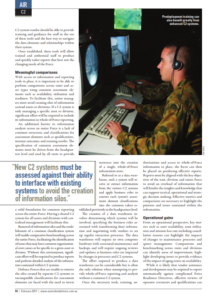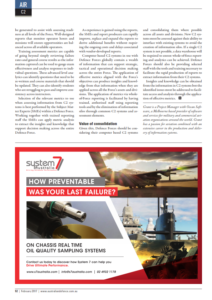 In February this year I had an article published about data access and analytics in Australian Defence Magazine. Focusing on Command & Control (C2) systems and the issues that must be addressed in order to access and analyse the copious amounts of information contained within them, the article also discussed the importance of having a “Whole of force” view of the C2 system data.
In February this year I had an article published about data access and analytics in Australian Defence Magazine. Focusing on Command & Control (C2) systems and the issues that must be addressed in order to access and analyse the copious amounts of information contained within them, the article also discussed the importance of having a “Whole of force” view of the C2 system data.
The full text of the article appears below. You can also access the article as a PDF by clicking on the link below.
Read the article as it appeared in the February issue of Australian Defence Magazine
 |
 |
 |
Making the most of a consolidated C2 framework
As Defence Forces around the world increasingly utilise computer based Command and Control (C2) systems, they are accumulating an enormous amount of information relating to operations at the unit level within their databases.
Ideally, this information should be converted to knowledge and insight that supports tactical, operational and strategic decision making, provided staff have full and easy access to the information and can apply effective metric based analysis reporting.
Computer based C2 systems are not solely restricted to operational information and processing as many also include training courses, asset management and personnel status. This in turn opens up access to historical information relating to unit currencies, personnel currencies, asset utilisation, course results and much more.
Unlocking the historical trove of information within these systems will allow the savvy operator to identify trends, determine the impacts of procedural change and perform “what if†analysis to assess potential future changes. Unfortunately, this information remains locked within a system unless staff are able to easily extract the information as and when they require, and in a format to suit their need.
While most C2 systems are installed on a Force’s servers and networks, in many cases their information can only be accessed through the system’s screens and existing reports. A handful of data extract reports are then provided which produce spreadsheets that are subsequently used by staff to perform further reporting. Additional updates made by staff to these spreadsheets can introduce errors and omissions if information is manipulated incorrectly or by accident.
Staff must be able to produce and run ad hoc reports directly on a system’s database using applications such as Crystal Reports or Microsoft SQL Server Reporting Services, and not incur the costs and delays associated with engaging the system vendor for each new or changed report. Staff also require a data dictionary that describes the data elements and their relationships within the database in order to facilitate effective report production. Your C2 system vendor should be able to provide training and guidance for staff in the use of these tools and the best way to navigate the data elements and relationships within their system.
Once established, these tools will allow trained & authorised staff to produce and quickly tailor reports that best suit the changing needs of the Force.
With access to information and reporting tools in place, it is important to be able to perform comparisons across units and asset types using common assessment elements such as availability, utilisation and readiness. To facilitate this, senior managers must avoid creating silos of information around assets or divisions. If a C2 system is only managing a specific asset or division, significant effort will be required to include its information in whole-of-Force reporting.
An additional barrier to information analysis across an entire Force is a lack of common structures and classifications for assessment elements such as qualifications, mission outcomes and training results. The specification of common assessment elements must be driven from the headquarters level and used by all units to provide a solid foundation for common reporting across the entire Force. Having a shared C2 system for all assets and divisions with centralised management will facilitate this.
Removal of information silos and the establishment of a common classification system will enable comparative benchmarking across the entire Force, facilitating the identification of issues that may have common organisational root causes or be specific to a given asset or division. Without this environment, significant effort will be required to produce reports and perform detailed analysis of the information contained within C2 systems.
Defence Forces that are unable to remove the silos created by separate C2 systems or incompatible classifications for assessment elements are faced with the need to invest resources into the creation of a single, whole-of-Force information store. Referred to as a data warehouse, such a system will receive or extract information from the various C2 systems and apply business rules to convert each system’s assessment element classifications into the common values established previously at the headquarters level.
The creation of a data warehouse involves determining which systems will be involved, specifying the business rules associated with transforming their information and negotiating with vendors to set up regular extraction processes. The data warehouse will require its own computer hardware with associated maintenance and backups and will require ongoing reviews and updates as business rules are impacted by changes in processes and C2 systems.
The effort required to produce a data warehouse can be considerable but is often the only solution when attempting to provide whole-of-Force reporting and analysis without a common C2 system.
Once the necessary tools, training, authorisations and access to whole-of-Force information in place, the focus can then be placed on producing effective reports. Reports must be aligned with the key objectives of the unit, division and entire Force to avoid an overload of information that will hinder the insights and knowledge that can support tactical, operational and strategic decision making. Effective metrics and comparisons are necessary to highlight the patterns and issues contained within the information.
From an operational perspective, key metrics such as asset availability, asset utilisation and mission loss rate including cancellation reasons can highlight the impacts of changes to maintenance processes and spares management. Comparisons and benchmarking across units and divisions can identify areas of improvement, highlight developing issues or provide evidence of the impact of aging assets on availability.
While it is likely that vendor assistance and development may be required to report automatically against complicated Force Readiness Directives, effective reviews of operator currencies and qualifications can be generated to assist with assessing readiness at all levels of the Force. Well-designed reports that monitor operator hours and missions will ensure opportunities are balanced across all available operators.
Training assessment metrics are capable of going beyond simply reviewing failure rates and general course results as the information captured can be used to gauge exam effectiveness and analyse responses to individual questions. These advanced level analytics can identify questions that need to be re-written and course materials that should be updated. They can also identify students who are struggling to pass and improve consistency across instructors.
Selection of the relevant metrics to use when assessing information from C2 systems is best performed by the Subject Matter Experts (SMEs) within a Defence Force. Working together with trained reporting staff the SMEs can apply metric analysis to extract the insights and knowledge that support decision making across the entire Defence Force. As experience is gained using the reports, the SMEs and report producers can rapidly improve, replace and expand the reports to derive additional benefits without requiring the ongoing costs and delays associated with vendor-developed reports.
Computer based C2 systems in use with Defence Forces globally contain a wealth of information that can support strategic, tactical and operational decision making across the entire Force. The application of effective metrics aligned with the Force’s objectives can produce insights and knowledge from that information when they are applied across all the Force’s assets and divisions. The application of metrics via whole-of-Force reporting is facilitated by having trained, authorised staff using reporting tools and by the elimination of information silos through common C2 systems and assessment elements.
Given this, Defence Forces should be considering their computer based C2 systems and consolidating them where possible across all assets and divisions. New C2 systems must be assessed against their ability to interface with existing systems to avoid the creation of information silos. If a single C2 system is not possible, a data warehouse will be required to ensure whole-of-force reporting and analytics can be achieved. Defence Forces should also be providing selected staff with the tools and training necessary to facilitate the rapid production of reports to extract information from their C2 systems.
Insights and knowledge can be obtained from the information in C2 systems but the identified issues must be addressed to facilitate access and analysis through the application of effective metrics.
About Grant McHerron:
Grant is a Project Manager with Ocean Software, a Melbourne based provider of software and services for military and commercial aviation organisations around the world. Grant has a passion for aviation combined with an extensive career in the production and delivery of information systems.

